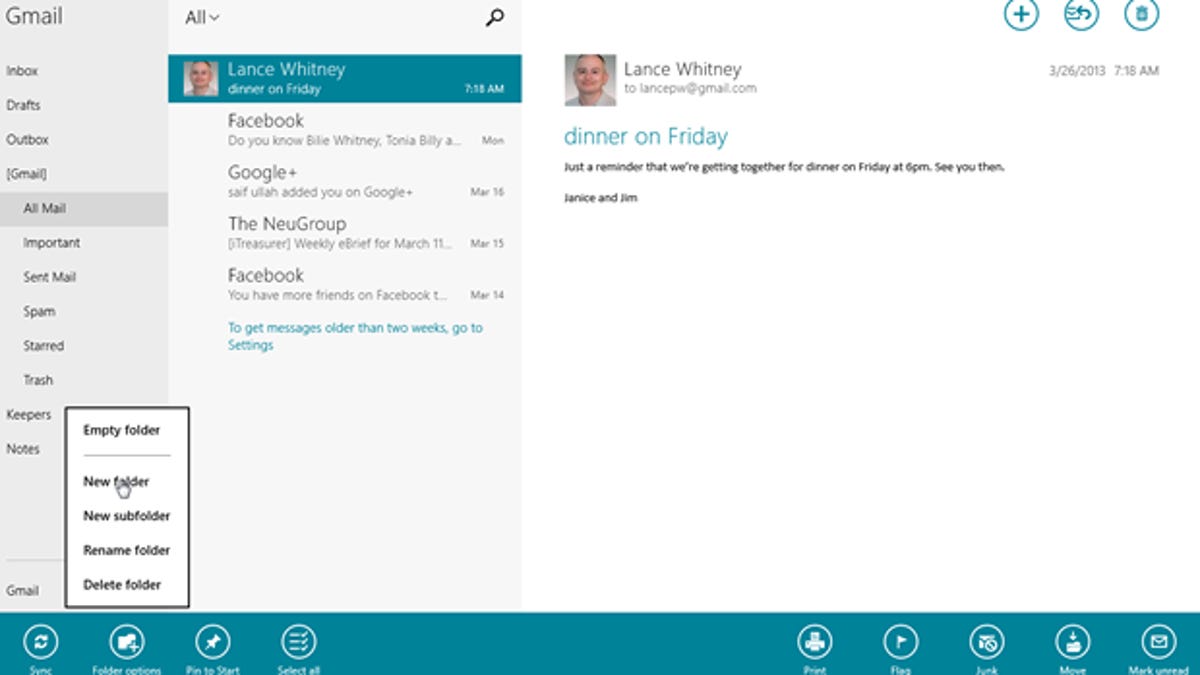Microsoft updates Windows 8 Mail, Calendar, and People apps
Microsoft's updated apps boast some helpful improvements, though people who also use Google Calendar have lost the ability to sync their appointments.

Microsoft has tweaked its Mail, Calendar, and People apps for Windows 8 and RT users with some much-need improvements.
The three core apps, which are bundled together, received some long overdue tweaks last night that make them a bit more user-friendly. But along with those improvements comes one negative: the Calendar app will no longer sync with Google Calendar appointments.
On the plus side, the Mail app now offers full folder management. You can create, rename, and delete folders and subfolders to better organize your e-mail.
Managing individual messages is also much easier. You can select multiple e-mails to delete, move, or print them. You can flag a message as important, mark it as unread, or banish it to the spam folder. A dedicated print button in the Mail app quickly opens the Print panel, so you don't have to manually navigate to the Print button on the Charms bar.
You can still access your Gmail account and contacts in the Mail app, though you'll need to re-sync your account after updating the app.
The Windows Calendar app is now easier on the eyes. Microsoft tweaked the font and colors used to display appointments so they're more readable. You can now view your calendar by work week in addition to date, full week, and month.
But you can no longer sync your Gmail appointments with the Calendar app. And the fault lies not with Microsoft but with Google, which cut off support for Microsoft's Exchange ActiveSync (EAS). Google announced in December that it would shut down Google Calendar Sync and a host of similar services.
The move renders the Windows Calendar app useless to me since I specifically used it to display my Google Calendar appointments. Microsoft has no workarounds at this point.
Microsoft initially seemed to promise continued support for people who connect their Google accounts to Mail, People, and Calendar. But Microsoft's Google services page now specifically states that "unfortunately, with Google changing the way it supports EAS, your Google calendar can't sync with the Calendar app."
The People app offers only a few changes. Right-clicking on the screen now displays a top appbar that lets you more easily navigate to the home screen, your own contact page, or a What's New page. You can now directly post to the Facebook wall of one of your friends by clicking on the person's name. You can also respond to the tweet of someone you follow on Twitter.
Accessing your Google contacts in the People app is tricky but still works. As with the Mail app, you have to remove your Google account and then re-enable it. After I did that, I was then able to see my Google contacts again. On the downside, the People app still lumps all your contacts together. So there's no way to see and separate just your Facebook, Twitter, or Google contacts.
Overall, the improvements to Mail, Calendar, and People are welcome. But the apps still seem half-baked.
Setting up, managing, and using these core Windows 8 apps is still trickier and clumsier than should be. Given the choice, I'd rather go directly to Microsoft Outlook or Gmail to check my e-mail, and to Facebook or Twitter to access my social networks.
Microsoft has proven that it knows how to build a solid Windows 8 app through its nicely designed News, Sports, and Weather apps. I wish some of the skills that went into designing those apps could be applied to Mail, Calendar, and similar core Windows 8 apps.

